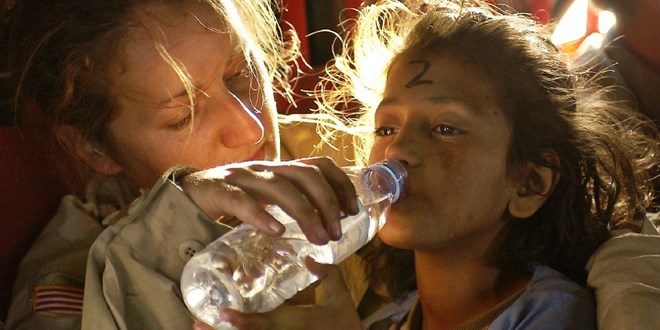IntraStra
Friday June 22, 2018

The number of people who faced forced displacement around the world hit a new record — up 2.9 million in 2017 from the previous year. The amount reached 68.5 million people displaced, over half of whom (52%) are underage.
The average of people made to leave their homes was more than 44 thousand a day in 2017. This is the equivalent of a person becoming displaced every two seconds. Forcibly displaced populations include 25.4 million refugees, 40 million internally displaced people (IDPs) and 3.1 million asylum-seekers.
Of the 25.4 million refugees, just over a fifth are Palestinians under the care of UNRWA. Of the remainder, for whom UNHCR is responsible, two-thirds come from just five countries: Syria, Afghanistan, South Sudan, Myanmar, and Somalia. An end to the conflict in any one of these has potential to significantly influence the wider global displacement picture.
The figures were released Tuesday (June 19, 2018) by the United Nations High Commissioner for Refugees (UNHCR). The new report, entitled Global Trends – Forced Displacement in 2017 draws a portrait of forced migrations across the globe — the outcome of persecution, conflict, or generalized violence. Every year on 20 June, World Refugee Day is an opportunity to bring renewed focus to the plight of all people who are forced to flee their homes. The UN General Assembly established the World Refugee Day in 2001, on the 50th anniversary of the United Nations (UN) Convention relating to the Status of Refugees.
One of the most vulnerable groups of displaced people is children who are unaccompanied by or have become separated from, an adult. At present, reliable figures on these children are hard to come by. According to asylum application figures, 45,500 such children were reported to have applied for asylum in 2017, although this figure is almost certain to be an underestimate.
SYRIA
Already in its seventh year, the Syria crisis has left over 13.1 million people in need of humanitarian assistance inside Syria. Out of these, 6.1 million people are internally displaced; 2.5 million live in hard-to-reach areas and 400,000 in besieged areas. Civilians continue to be the primary victims of the conflict with children and young people comprising more than half of the displaced population. There are over 5 million registered Syrian refugees in Turkey, Lebanon, Jordan, Iraq, and Egypt.
AFGHANISTAN
Almost four decades of violence have led to large-scale displacement within the country, and to neighboring Iran and Pakistan. Intensified conflict continues to force people out of their homes: in 2017 alone, almost half a million people became internally displaced. Pakistan continues to host the largest number of Afghan refugees (around 1.4 million), while Iran hosts almost 1 million. In addition, there are almost 3 million Afghans living in Pakistan and Iran without having refugee status.
SOUTH SUDAN
By the end of May 2018, close to 2.6 million South Sudanese had fled the country. The total number of refugees is now almost double what it was at the start of 2017 and is expected to continue rising. South Sudan – a country with one of the youngest populations in the world – produces one of the highest numbers of refugees in the world.
MYANMAR
Due to the outbreak of violence in Rakhine State at the end of August 2017, 655,500 Royhinga people were forced to cross the border into Bangladesh, where they were granted temporary protection. Most of the population are women and children.
SOMALIA
In Somalia, drought and floods have displaced close to 2.6 million people since January 2016. The situation of displacement in and around Somalia is complex and dynamic. In addition to those being internally displaced due to conflict and famine, Somalia is also experiencing the return of refugees, mainly from Kenya (60,800 Somali refugees have returned from Kenya since December 2013) and Yemen (30,600 Somalis have returned since March 2015). At the same time, the risk of large numbers of Somalis leaving the country as refugees to seek protection and safety remains high.